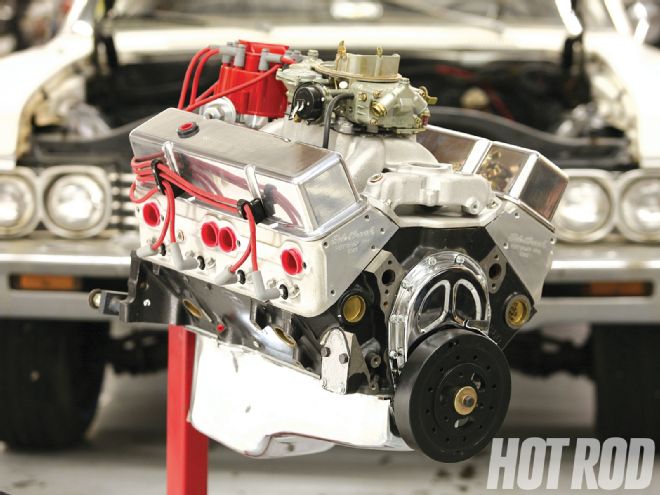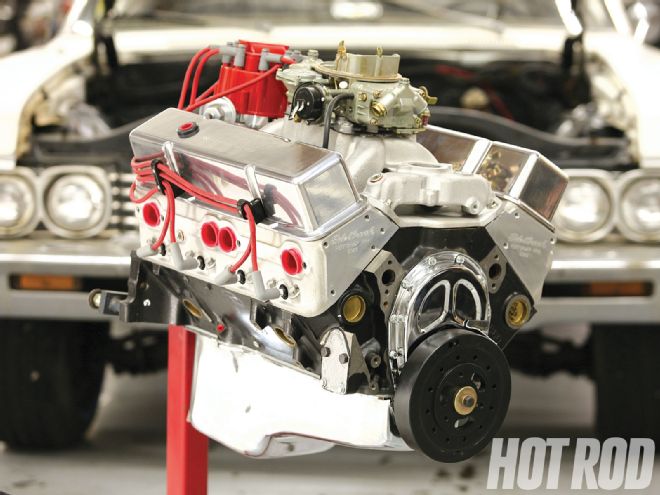
Internally, we've joked forever about a story like this one: how to install a small-block Chevy in a car that came with a small-block Chevy. What could be more self-evident? What could have been covered more times than that?
 Here's the Smeding Performance 383 Extreme crate engine we're installing. According to the dyno sheet that came with it, the motor makes 441 hp at 5,400 rpm and 423 lb-ft at 4,000 to 4,300 rpm. It has 9.8:1 compression, aluminum heads, and a 231/236-at-0.050 hydraulic roller camshaft with a 111-degree lobe-separation angle. This is an older version of the engine with a Holley carb; Smeding now uses a Quick Fuel 750 atop the Air-Gap manifold.
Here's the Smeding Performance 383 Extreme crate engine we're installing. According to the dyno sheet that came with it, the motor makes 441 hp at 5,400 rpm and 423 lb-ft at 4,000 to 4,300 rpm. It has 9.8:1 compression, aluminum heads, and a 231/236-at-0.050 hydraulic roller camshaft with a 111-degree lobe-separation angle. This is an older version of the engine with a Holley carb; Smeding now uses a Quick Fuel 750 atop the Air-Gap manifold.
As it turns out, it's not as obvious as it may seem based on the number of tech letters we get with very basic questions. Also, from our informal industry polls, it's clear that classic small Chevys are still the most-sold crate engines in the country despite the ever-growing popularity of the Gen III and IV V-8 swaps. That means there are still countless Mouse motors being bolted in place every day, perhaps by guys who have never done it before.
This story is far from a complete blow-by-blow of the remove-and-replace procedure, but it does contain a number of tips and tricks that can help the process of changing the engine in just about anything, but especially in any car with a small-block Chevy. The car shown here is our '67 Impala convertible, and the motor is a Smeding Performance 383 Extreme stroker small-block. Concurrent with the engine change, we removed the car's factory Powerglide two-speed automatic trans and swapped to a 700-R4 auto-overdrive and matching torque converter from Bowler Performance Transmissions. The combo of a 383 and a 700-R4 makes this drivetrain virtually identical to about half the cars on a HOT ROD Power Tour road trip. It's simple, fun to drive, and gets decent mileage. Here's how to make it happen in your car.
Shopping List
Here's a reminder of all the little extras you may need to consider replacing or upgrading, saving you a hundred trips to the parts store.
• Radiator and heater hoses, fan belts, radiator cap
• Pipe plugs for open holes in the intake, block, or water pump
• New water pump
• Thermostat and housing
• Distributor gasket
• Spark plugs and wires
• Engine and transmission mounts
• Transmission crossmember for 700-R4 swap
• Shortened driveshaft (for a 700-R4 swap)
• Alternator and bracket
• Flexplate and bolts (to the crank and to the converter)
• Trans-to-engine bolts
• Headers and gaskets, header bolts, collector bolts
• New starter, or a ministarter to clear your headers
• Air cleaner
• Fluids: oil, ATF, power steering fluid, coolant, RTV
• Trans cooler fittings and lines
• Fuel pump and delivery lines and fittings, carb inlet set
• Speedo cable adapter
• Throttle linkage parts: Heims, balls, cables, brackets
• Trans TV or kickdown cable and brackets
• Throttle return springs and brackets
• Spray paint for detailing
• Intake manifold vacuum fittings and vacuum lines for distributor, trans, and power brakes
• Battery and cables
• Get your radiator cleaned out or get a new one
• Engine and trans dipsticks
• PCV valve, hose, and valve cover grommets and breathers
Checklist Of Stuff You'll Need To R&R
There are lots of little things that will need to be unbolted from your old engine and replaced on the new one. This will vary from car to car, depending on the accessories involved, but here's a good overview of the stuff you'll need to R&R on nearly any older, carbureted car.
We'll start at the front of the car and work our way to the rear, presuming you're removing the engine with the transmission attached.
• Pull the hood first; it makes everything easier to work on (if you have a Fox Mustang, the hood will just flop clear back out of the way).
• Battery and cables, including the engine-to-chassis ground strap
• Engine wiring harness, including wires to the alternator, starter, distributor, coil, and any gauge sensors; don't forget the neutral safety switch on applications such as Mopars where the wire goes to the transmission
• Radiator, including heater hoses and the auto-trans cooler lines on many stock cars
• Engine front-drive accessories, such as the fan, alternator, and power steering pump; it's usually easiest to get the engine out with all this stuff out of the way
• Spark plug wires and distributor (on most Chevy applications and small Mopars, it's best to pull the distributor so you do not smash it on the firewall during engine removal)
• Exhaust headers or manifolds. On cars with shorty headers or manifolds, it might also make it easier to remove or drop the entire exhaust system. While the starter can stay in place on most cars if you are leaving the trans attached, some header designs might require starter removal.
• Throttle linkage (and perhaps trans-kickdown or TV linkage, or a vacuum line) and fuel lines to the pump and carburetor
• Engine-mount bolts
• Transmission shift linkage
• Speedometer cable (just remove it from the trans)
• Transmission mount bolts (and, in most cases, you'll also want to unbolt the trans crossmember from the frame after supporting the trans with a jack)
• Driveshaft